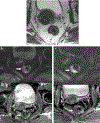Diagnostic accuracy of b800 and b1500 DWI-MRI of the pelvis to detect residual rectal adenocarcinoma: a multi-reader study
- PMID: 31690966
- PMCID: PMC7386086
- DOI: 10.1007/s00261-019-02283-x
Diagnostic accuracy of b800 and b1500 DWI-MRI of the pelvis to detect residual rectal adenocarcinoma: a multi-reader study
Abstract
Purpose: To compare the sensitivity, specificity and intra-observer and inter-observer agreement of pelvic magnetic resonance imaging (MRI) b800 and b1500 s/mm2 sequences in the detection of residual adenocarcinoma after neoadjuvant chemoradiation (CRT) for locally advanced rectal cancer (LARC).
Introduction: Detection of residual adenocarcinoma after neoadjuvant CRT for LARC has become increasingly important and relies on both MRI and endoscopic surveillance. Optimal MRI diffusion b values have yet to be established for this clinical purpose.
Methods: From our MRI database between 2018 and 2019, we identified a cohort of 28 patients after exclusions who underwent MRI of the rectum before and after neoadjuvant chemoradiation with a protocol that included both b800 and b1500 s/mm2 diffusion sequences. Four radiologists experienced in rectal MRI interpreted the post-CRT MRI studies with either b800 DWI or b1500 DWI, and a minimum of 2 weeks later re-interpreted the same studies using the other b value sequence. Surgical pathology or endoscopic follow-up for 1 year without tumor re-growth was used as the reference standard. Descriptive statistics compared accuracy for each reader and for all readers combined between b values. Inter-observer agreement was assessed using kappa statistics. A p value of 0.05 or less was considered significant.
Results: Within the cohort, 19/28 (67.9%) had residual tumor, while 9/28 (32.1%) had a complete response. Among four readers, one reader had increased sensitivity for detection of residual tumor at b1500 s/mm2 (0.737 vs. 0.526, p = 0.046). There was no significant difference between detection of residual tumor at b800 and at b1500 for the rest of the readers. With all readers combined, the pooled sensitivity was 0.724 at b1500 versus 0.605 at b800, but this was not significant (p = 0.119). There was no difference in agreement between readers at the two b value settings (67.8% at b800 vs. 72.0% at b1500), or for any combination of individual readers.
Conclusion: Aside from one reader demonstrating increased sensitivity, no significant difference in accuracy parameters or inter-observer agreement was found between MR using b800 and b1500 for the detection of residual tumor after neoadjuvant CRT for LARC. However, there was a suggestion of a trend towards increased sensitivity with b1500, and further studies using larger cohorts may be needed to further investigate this topic.
Keywords: Chemoradiation; Diffusion weighted imaging; MRI; Rectal cancer; b value.
Figures


References
-
- Napoletano M, Mazzucca D, Prosperi E, Aisa MC, Lupattelli M, Aristei C, Scialpi M (2019) Locally advanced rectal cancer: qualitative and quantitative evaluation of diffusion-weighted magnetic resonance imaging in restaging after neoadjuvant chemoradiotherapy. Abdom Radiol (NY). 10.1007/s00261-019-02012-4 - DOI - PubMed
-
- Amodeo S, Rosman AS, Desiato V, Hindman NM, Newman E, Berman R, Pachter HL, Melis M (2018) MRI-Based Apparent Diffusion Coefficient for Predicting Pathologic Response of Rectal Cancer After Neoadjuvant Therapy: Systematic Review and Meta-Analysis. AJR Am J Roentgenol 211 (5):W205–W216. 10.2214/ajr.17.19135 - DOI - PubMed
-
- Blazic IM, Lilic GB, Gajic MM (2017) Quantitative Assessment of Rectal Cancer Response to Neoadjuvant Combined Chemo-therapy and Radiation Therapy: Comparison of Three Methods of Positioning Region of Interest for ADC Measurements at Diffusion-weighted MR Imaging. Radiology 282 (2):418–428. 10.1148/radiol.2016151908 - DOI - PubMed
-
- Foti PV, Privitera G, Piana S, Palmucci S, Spatola C, Bevilacqua R, Raffaele L, Salamone V, Caltabiano R, Magro G, Li Destri G, Milone P, Ettorre GC (2016) Locally advanced rectal cancer: Qualitative and quantitative evaluation of diffusion-weighted MR imaging in the response assessment after neoadjuvant chemo-radiotherapy. Eur J Radiol Open 3:145–152. 10.1016/j.ejro.2016.06.003 - DOI - PMC - PubMed
MeSH terms
Grants and funding
LinkOut - more resources
Full Text Sources
Research Materials

